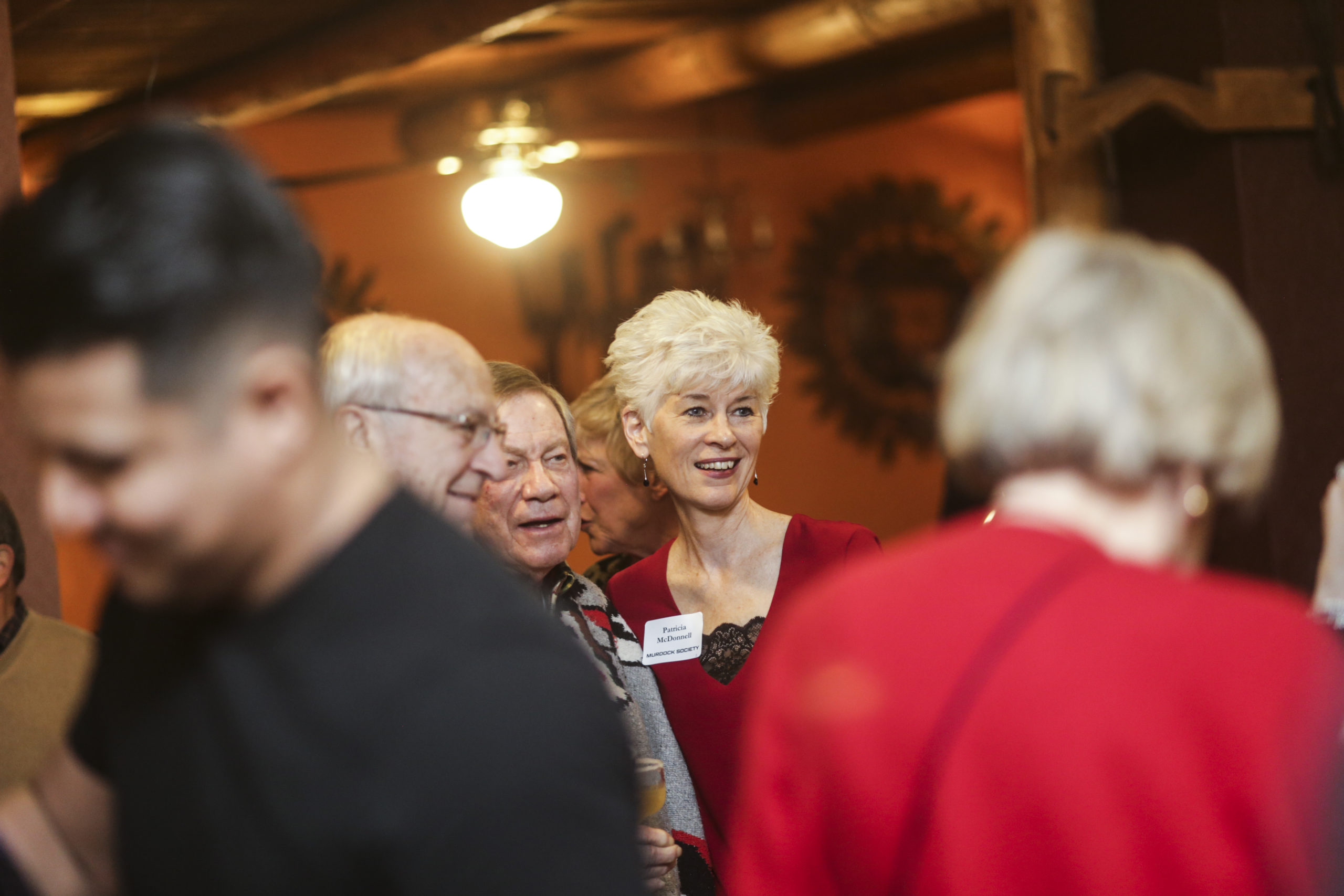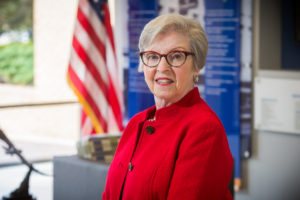Travel. Grandchildren. Age. Love.
These are some of the reasons people give up jobs that have seemed more like callings. But even those compelling reasons don’t make the actual decision to retire easy.
The Active Age spoke to five people who recently decided to step away from highly fulfilling careers. All were thankful for the opportunities they’d had to make a difference, comfortable with their next chapters in life and yet a bit wistful.
Dona Gibson
“Deciding to retire was a decision I had dreaded for years,” said Dona Gibson, who retired from Friends University in December after 40 years with the school. “Fortunately, my wise husband had retired seven years before I did and told me, ‘You’ll know when it’s time.’ The pandemic actually gave me a practice time to begin to slow down and focus on life as a whole rather than life as a career. But the shorter answer to the question is rather simple: 40 years sounded like a good length of time to have made a contribution.”
In addition to teaching in the Division of Education, Gibson directed the master’s teaching program from 1991 until her retirement, helped create the university’s international travel and study program and herself presented at teaching education conferences in Kenya and China. The travel program has given more than 500 students experience abroad.
Teaching teachers, Gibson said, was a way of impacting young minds far beyond the walls of her classroom.
“My teaching life for many years has been totally devoted to working with graduate students who are already classroom teachers. The experience of accompanying and encouraging them on their journey has given me such an awe and admiration for the huge impact of P-12 teachers on their students’ experience. I hope and believe I’ve had some part to play in their lives.”
Gibson’s connection with Friends actually goes back considerably farther than four decades. As an 8-year-old, she attended a symphony concert in Friends’ Alumni Auditorium and told her mother: “I want to live here.” She said colleagues such as Cecil Riney, Moses Rumano and Friends President Amy Carey had a profound effect on her life.
Gibson will keep a connection to Friends as a professor emeritus but also is ready for a different focus.
“Like every other retiree, definitely traveling more is one plan,” she said. “My volunteer life has picked up dramatically as well, which I highly recommend even to folks still working!”
Pat Gallagher
Pat Gallagher might have thought her working career had peaked with her first real adult job when she got hired in Washington, D.C., by a fledging hotel operator.
“His name was Bill Marriott,” Gallagher said of the billionaire chairman of what’s now Marriott International.
But Gallagher found another job in Wichita that kept her busily engaged in the city’s business community for 40 years. Gallagher worked as government relations manager and military liaison for the Wichita Regional Chamber of Commerce for 32 of those years. She intended to retire eight years ago, but was persuaded to stay on part-time as the liaison until last month. In that job, she chiefly worked with McConnell Air Force Base.
“The military has been a part of my job for a long, long time. It’s unique in that a lot of people don’t understand the culture, the lifestyle, the ranks. It was always my favorite part of my job.”
Gallagher is best known for helping bringing the KC-46A Pegasus tanker program to McConnell. Basing the aerial refueling tankers here is estimated to have a $200 million economic impact on Kansas annually, while the base’s overall impact is estimated at more than $600 million per year. The first tankers arrived in 2019.
“That was probably eight years, maybe 10,” Gallagher said of the work to bring the program here. “We did a lot of lobbying, a lot of congressional work. Fortunately, we had an ‘A team’ in our congressional delegation, so they were very helpful to us. And also the city and county commission. It was definitely a unified front and a partnership also with Derby and Andover and all the surrounding communities.”
Gallagher is proud of another community project that wasn’t directly related to her job but was supported by the chamber: the Boundless Playground in Sedgwick County Park for children of all abilities that was sponsored by the West Sedgwick County Sunrise Rotary Club. Gallagher chaired the effort.
“Because I had worked closely with the county for decades, we were able to get in front of the commission, and they granted us that land. I think that was the most personally exciting thing I was involved in outside work, per se.”
Retiring “was a hard decision because I absolutely loved what I did,” Gallagher said. “However, I am now 80 years old and I am getting tired. We need to get another generation involved.”
She plans to return to the nation’s capital to be near her two grown children; her son is a colonial archeologist, and her daughter is a federal lobbyist.
“When I leave this community, I will definitely stay in touch with it.”
Patricia McDonnell
Patricia McDonnell always figured she’d lead the Wichita Art Museum until she was at least 70 years old. After all, she isn’t lacking in energy.
“I worked 60, 70, sometimes 80 hours a week,” the WAM director, who’s 66, said. “We’re all animated by the work we do.”
Then an unexpected thing happened: She fell in love and married the photographer Larry Schwarm in October. “I tried really hard not to work that many hours and couldn’t do it.”
McDonnell’s retirement becomes official this month, ending an exciting decade at WAM. Under McDonnell, the museum saw attendance increase by more than 60 percent and its membership rise by 150 percent, with annual gift income doubling and long-term resources growing by $9 million.
The same period brought several blocker exhibitions to Wichita, including Monet to Matisse in 2018, Georgia O’Keeffe: Art, Image, Style in 2019 and American Art Deco this year. “With Monet, we doubled our membership within a year,” McDonnell said. The museum’s own collection grew by a third thanks to acquisitions of folk art, work by the Prairie Print Makers, Preston Singletary, Schwarm and others.
There were physical changes to WAM, starting with the Art Garden’s creation in 2015, a $3.3 million project. “That wholly transformed our grounds, but I would tell you it also transformed our building,” McDonnell said. “This is a high-modern, stripped-of-ornamentation building that’s not going to be to everybody’s taste, but when the grounds around it are undulating and lush, with over 200 plants and 100 trees, it really made a difference.”
WAM renovated some interior spaces in 2020 and this year saw the installation of dramatic new entry art commissioned from Beth Lipman. “It’s massive, it’s spectacular,” McDonnell said. “Animating the lobby to elevate the visitor experience was part of a strategic plan we developed four years ago, and oh my gosh, (Lipman’s work) does it.”
Then there’s WAM’s first-ever diversity, equity and inclusion policy, which was approved by its board in December with the goal of making sure all visitors feel welcome. As many brides know, McDonnell also rescinded the rule against weddings at WAM as one of her first moves.
McDonnell called the decision to retire “hard and bittersweet.” She imagines more gardening, travel and fiction reading are in her future, hinting that she may also return to art history and scholarship, her original specialty. But she’s not sorry she spent a good part of her career running WAM.
“I was drawn into the art world by just a very serious passion for art. It just turns me on. Over the years, I’ve grown, and the greater deeper personal reward for me is the social purpose of art museums. It’s the people who come. The art is on our walls to transform lives.”
Greg Bogue
Dr. Greg Bogue did more than just retire when he left Bogue Animal Hospital earlier this year. He ended a 92-year run by veterinarians named Bogue in Wichita.
“For me, it was a very bittersweet thing. I loved what I did. I was blessed and humbled to be able to serve people over the years, including people I picked up from dad and granddad and my Uncle Robert.”
Bogue performed nearly 5,000 surgeries on pets during his 31 years of practice in Wichita while serving about 17,000 clients, many with multiple pets. That includes many dogs and cats but also pot-bellied pigs, snakes, birds, ferrets, goats, rabbits and even a few chimps, horses, cows and sheep. The thriving practice employed hundreds of dog walkers, groomers and other kennel staff through the years.
Bogue was appointed to the Kansas Board of Veterinary Examiners by governors from both political parties, serving three years as its president.
Despite his family background, Bogue didn’t actually set out to become a veterinarian. After graduating in the 1970s from Kansas State University, where he also played for the football team, he worked in the feed manufacturing industry. Bogue returned to K-State to earn his veterinary degree in 1991, but not before surviving an early bout with colon cancer. He worked with his father for about a year before taking over the business with his wife, Cindy, in 1993.
“I had the privilege of carrying the family name for a third of the time we were in business.”
Another huge challenge arrived with the Halloween flood of 1998, which threatened to ruin the hospital’s new building.
“It was a punch, but there were a lot of great people that came along and helped us,” Bogue said. “We lost one day of business, and we had water up to our waist, moving fast and cold. We had live animals in the building. We lived in a state of disorganized organization for probably six weeks. Everybody just kind of bucked up, you might say.”
Bogue sold the business to a company with about 500 veterinary practices nationwide three years ago. “They want the community aspect left intact, and I want it. I tried to get things lined up for the staff I have, which is very good.”
Bogue said the sale “wasn’t out of being disgruntled by any stretch” but was about making “the time to do more of what you want.”
“I’m pushing 69, so what do you do?”
Now that will include more volunteering and travel, becoming even more active in the couple’s church, spending time at a second home on Table Rock Lake and spending time with six grandchildren divided between North Texas and the Kansas City area.
It’s about “being able to come and go when we want, to get caught back up on watching ballgames, like many grandparents like to do.”
Jan Haberly
When Jan Haberly took over running the Lord’s Diner a decade ago, it consisted of a single facility on North Broadway serving dinner to those who need it 365 days a year.
Today, there are two more Lord’s Diners — on South Hillside and in Pittsburg, Kan. — plus three food trucks and one more mobile unit on the way.
The multiple Diners have served more than 6.5 million meals since 2002.
The continued need to combat hunger here is nothing to celebrate, but it’s somewhat frightening to consider what might have happened without the Diners.
“We care for people that can’t take care of themselves,” Haberly said. “We don’t judge. It’s easy to say, ‘Why don’t you quit doing drugs?’ or ‘Why don’t you get a job?’ But it’s not easy.”
Now, Haberly is retiring from that work, although it’s not because of any less passion for it.
“It’s a horrible decision, but I kind of set a milestone,” she said. “Ken (her husband) just retired a year ago. He’s just enjoying it so much I thought I needed to do that. None of us know how long we’ve got. I’m young and healthy and want to take advantage of that.”
Haberly said she will aways appreciate the way the community supports the Lord’s Diner — both in terms of donations and volunteering — which is what allowed it to grow.
To some extent, she said, the work grew more challenging in recent years.
“When I started, the homeless clientele were just a different breed. Today, there’s a whole lot more mental illness and drugs. I think a lot of them try to self-medicate.”
Then the pandemic hit, and the Diners started serving all meals to go. Clients who had some kind of housing or shelter to take their food to actually seemed to like the change, Haberly said. Those without it “suffered. They had to sit outside and eat.” Some also grew “wilder” without the restrictions the Diners put on people eating inside. The Diners recently started serving dinner inside again, although they may keep the to-go option for people who want it.
Haberly said she and her husband plan to spend more time with their grandchildren and travel. “We have a motor home. We’re still trying to decide how to do it. Neither one of us has really seen a lot of the United States.”














